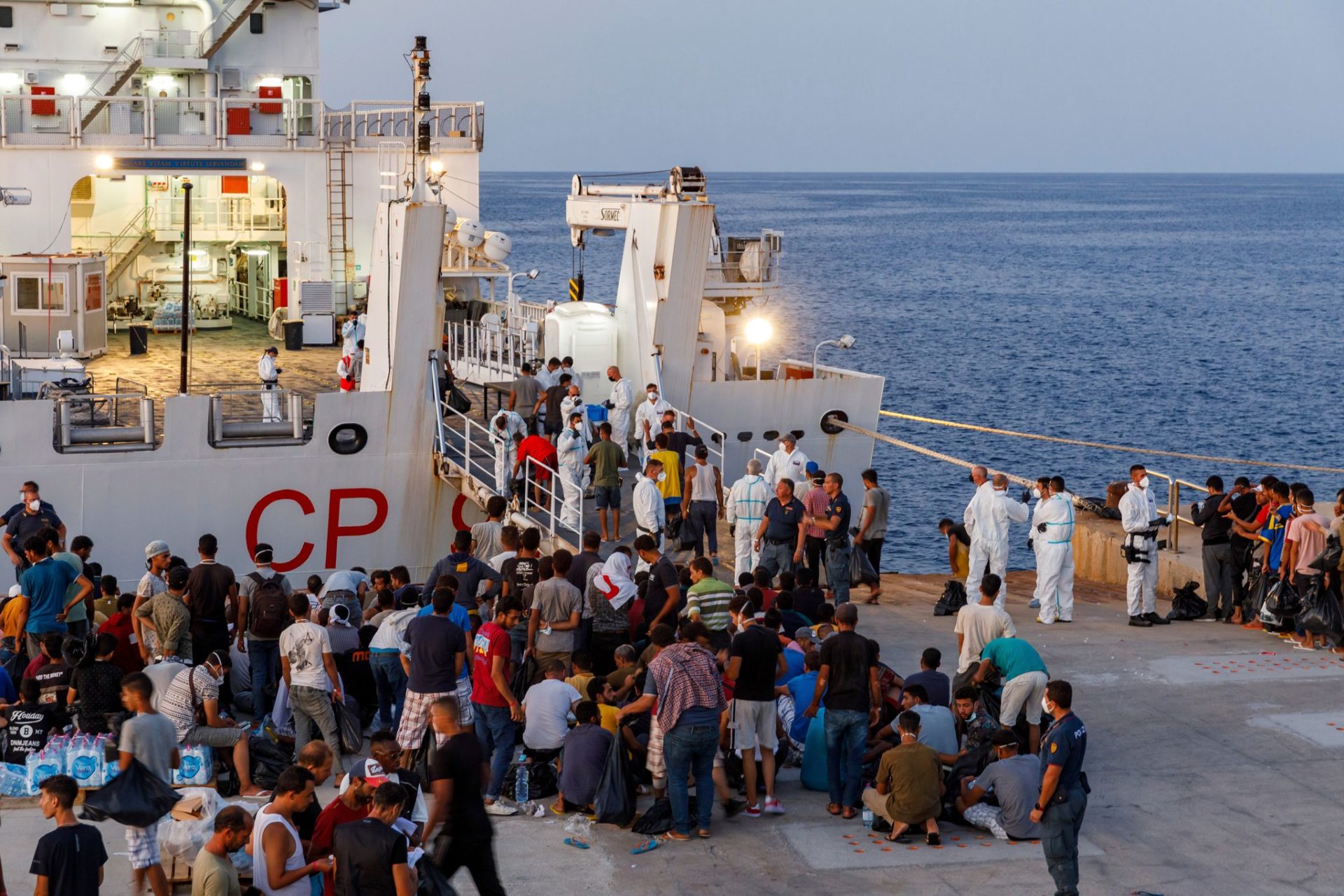Ten years on: How Europe’s 2015 migration wave redefined societies

Brussels (enr) – Ten years after the start of the 2015 migration wave, EU Migration Commissioner Magnus Brunner said the European Union decides who does or doesn’t cross its borders. To manage the further arrival of migrants from outside the EU, he called for more effective returns and stronger cooperation with third countries.
“After ten years of negotiations, we are putting in place a modern migration system that restores control over who can come to Europe – and who cannot,” Brunner told the European Newsroom (enr) in written replies, referring to the Pact on Migration and Asylum that is set to enter into force in June 2026.
The Pact is a set of new rules managing migration and establishing a common asylum system at EU level. According to EU border agency Frontex, it “will ensure that the Union has strong and secure external borders, that people’s rights are guaranteed, and that no EU country is left alone when under pressure.”
“We are getting our European house in order, and ensuring that we have the right legal framework to be able to set up fast, efficient and streamlined procedures for asylum and return and a harmonised system for managing the arrival of non-EU nationals,” Brunner said.
“To prevent people from going on dangerous journeys, we need [to] engage with third countries along the route as well as in countries of origin,” the Austrian Commissioner said.
When asked how the EU intends to rebuild public trust in the face of growing discontent with mass immigration, Brunner said “the priority on migration should be to [instill] confidence among people that we have control over what happens in Europe”.
A decade after after “Wir schaffen das”
The images have gone down in history: lines of exhausted men and women carrying their belongings on their backs, trudging through central Europe in early September 2015.
On August 31, then German chancellor Angela Merkel said the famous three words in German “Wir schaffen das” (“We can do this”) as thousands of refugees marched along a motorway in Hungary towards Germany. No one could have guessed at the time that those words would become the most famous statement of her 16-year chancellorship.
Merkel and the then Austrian Chancellor Werner Faymann decided during the night of September 4 to 5, 2015, to keep the two countries’ borders open.
Within a few months, Germany had welcomed hundreds of thousands of people, most of them fleeing conflicts in Syria, Iraq or Afghanistan – a watershed moment that would deeply divide the country.
2015 is said to have enabled the rise of Germany’s far-right Alternative for Germany (AfD).
According to Marko Lovec, professor at the International Relations Chair at the Ljubljana Faculty of Social Sciences, the new migration situation was one of the main drivers of the change in the political atmosphere in Europe. Since 2014, right-wing, eurosceptic and populist parties have used migration as one of the key topics ahead of national and EU elections.
A perilous journey to prosperity
At the European level, the right to asylum, enshrined in the Geneva Convention and ratified in 1951 by 155 states, meant that more than 1 million people could file an application in the European Union in 2024.
Many migrants enter the European Union through Greece, then travel up north via EU candidate countries Serbia and North Macedonia. Others decide to move west, using the Albanian or Kosovo routes.
Due to its geographic location, North Macedonia is used as a corridor between Greece and Serbia. Migrants face many challenges during their journey: arbitrary detentions and expulsions, abuse and ill-treatment, even death.
Smugglers traffic migrants into the country and collect large amounts of illegal profits (between 500 to 1,500 Euro per person) for bringing them from Greece to Serbia.
Croatia is also located on the under-pressure Western Balkan route. Like North Macedonia, it is a transit station on their way to wealthier member states – mainly Germany, Austria, and Sweden.
In 2015 – when the government was led by then Prime Minister Zoran Milanović – Croatia’s policy was to let migrants into the country, though only to take care of the sick and infirm before transporting them further to the borders with Hungary and Slovenia. It refused to become a hotspot or reception center from which refugees would be relocated further to northern EU member states.

Another popular yet dangerous route leads from Northern Africa and the Middle East to Italy, with many travelling by boat turning the Mediterranean Sea into a mass grave.
According to the United Nations Refugee Agency (UNHCR), arrivals by sea peaked in 2016 at 181,436, of which 4,578 people have died or gone missing. Numbers have fluctuated over the years but the number of dead or missing persons is staggering.
Arrivals decline but integration and inclusion prove uneven
Germany, Spain, Italy, France, and Greece alone account for nearly 80 percent of EU asylum applications in 2024, according to the French Office for the Protection of Refugees and Stateless Persons (OFPRA).
Germany remained the leading destination country with 237,000 applications, or 23 percent of all applications filed in the EU, followed by Spain, Italy and France.
Cyprus remains the country with the highest number of asylum applications per capita (1/138 inhabitants), ahead of Greece (1/141 inhabitants).
Data however shows the number of applications are decreasing even as the debate around them hardened.
In Germany, applications fell by almost 60 percent in August this year, with a total of 7,803 people applied for asylum for the first time in August, compared with 18,427 last year, the interior ministry said on Tuesday.
The drop comes as Germany pursues various measures to curb migration under Chancellor Friedrich Merz, who took office in May. Merz’s government has taken harsh measures like imposing strict border controls and deporting convicted criminals to their Taliban-controlled homeland Afghanistan.
A similar decline occurred in Spain where between January and September this year 23,931 migrants arrived in Spain, 11,578 fewer than in the same period last year.
Despite being a country on the frontline, anti-immigration narratives have not yet taken root in Spain, although in recent months there have been some incidents.
For example, in July violent anti-immigrant riots occurred in the town of Torre-Pacheco after a 68-year-old pensioner said three men of North African origin attacked him without provocation on July 9.
The sudden outbreak of violence took Spain by surprise but anti-migrant discourse had already been brewing, partly due to disinformation circulating on social media.
Fact check: Disinformation catalyses anti-migrant unrest in Spain
AFP’s digital verification team in Spain has debunked many false claims linked to immigrants. A viral video showing a homeless man attacked in Almería (Spain) in May was decontextualized and helped fuel anti-immigrant violence, falsely linking it to the Torre-Pacheco incident.
Read AFP’s full fact check in French: https://factuel.afp.com/doc.afp.com.683E4WE
Neighbouring Portugal pledged to receive around 4,500 asylum seekers when the refugee crisis erupted in 2015. In practice, the country welcomed roughly 1,550 refugees between 2015 and 2018, many of them transferred from camps in Greece and Italy.
Integration efforts were coordinated through a mix of governmental and civil society initiatives. Refugees were provided with housing, healthcare, education, and Portuguese language courses. Employment programs were also developed, though matching skills to labour market needs proved difficult.
One of the hallmarks of the Portuguese approach was dispersal. Instead of concentrating refugees in large urban centers, authorities distributed families across towns and villages nationwide. This strategy fostered close community bonds but also left many refugees feeling isolated from broader diasporas. Language barriers and the non-recognition of professional qualifications further complicated integration.
In Bulgaria, much of the debate focused on the labour market. A survey by the Myara sociological agency in March found that more than half of Bulgarians oppose allowing migrants to take jobs in the country, even in the face of labour shortages.
In France, the government announced in July that legal foreigners’ registration with the country’s public employment service France Travail will be automatic shortly after their arrival in France, the government announced, aiming to “fight unemployment” among non-EU newcomers. The government said the unemployment rate for non-EU foreigners legally residing in France was 16.4 percent.
In Germany, nearly two thirds of refugees who came in the 2015 wave had jobs by 2022, according to the latest data from the Institute for Employment Research (IAB). But many migrants have yet to find work. They are four times more likely to be jobless than the rest of the population, with an unemployment rate of 28 percent last year.
Italy is home to almost 2.4 million foreign workers, according to the Ministry of Labour and Social Policy – equivalent to more than 10 percent of the total workforce active in the country. While bringing multiculturalism to the country, many face structural challenges to integrate, including linguistic and bureaucratic barriers, as well as trouble finding housing.
Withstanding the test of time
Ten years after her legendary statement – “We can do this” – Angela Merkel believes Germany has made significant progress in integrating migrants.
Merkel admits the country was “not well prepared” at the time for this “enormous task” and that there have been “disappointments”. Nevertheless, she points to the “incredible effort” put in by many to welcome the new arrivals.
This article is an enr Key Story. The content is based on news by agencies participating in the enr.















































